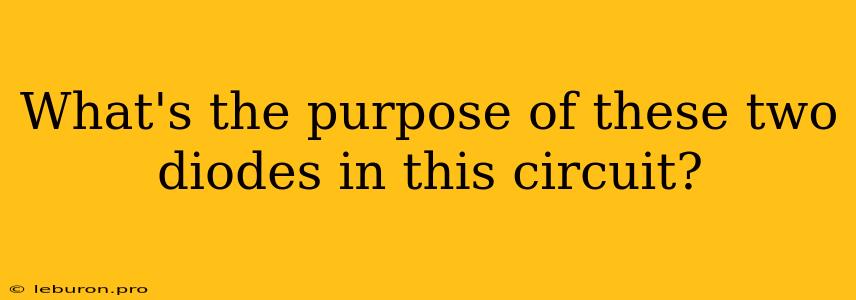Understanding the Purpose of Diodes in a Circuit
Diodes are essential components in electronic circuits, acting as one-way gates for electrical current. They allow current to flow in one direction while blocking it in the opposite direction. This fundamental property makes them incredibly versatile, enabling a wide range of applications. When encountering a circuit with multiple diodes, it's crucial to understand the function of each diode to grasp the overall circuit behavior. This article explores the purpose of two diodes in a circuit, focusing on common configurations and their respective functionalities.
Common Diode Configurations and Their Purposes
Diodes are often used in pairs to achieve specific circuit functions. Here are some common configurations and their purposes:
1. Diode Rectifier:
The most basic application of two diodes is in a rectifier circuit. This configuration converts alternating current (AC) to direct current (DC).
- How it works:
- A full-wave rectifier typically uses two diodes in a bridge configuration.
- During one half-cycle of the AC input, one diode conducts while the other is reverse-biased.
- During the next half-cycle, the diodes switch roles, ensuring that current always flows in the same direction through the load.
- Purpose:
- Rectifier circuits are fundamental for converting AC power from the mains to DC power required by electronic devices.
- They are used in power supplies, battery chargers, and many other applications.
2. Diode Clamping:
Diode clamping circuits use one or more diodes to limit the voltage swing of a signal. This prevents the signal from exceeding a specific voltage level.
- How it works:
- A diode clamp typically uses a diode in parallel with the load, connected to a reference voltage.
- The diode conducts when the signal voltage exceeds the reference voltage, preventing it from going further.
- Purpose:
- Clamping circuits are used to protect sensitive components from overvoltages, shape signals, and improve circuit performance.
- They are commonly found in amplifiers, signal processing circuits, and power supplies.
3. Diode Voltage Doubler:
A diode voltage doubler circuit uses two diodes and capacitors to create a DC output voltage that is double the peak voltage of the AC input.
- How it works:
- The first diode charges a capacitor during the positive half-cycle of the AC input.
- The second diode charges a second capacitor during the negative half-cycle of the AC input.
- The two capacitors are connected in series, effectively doubling the voltage.
- Purpose:
- Voltage doublers are used in high-voltage applications where it is necessary to increase the DC voltage level.
- They are found in applications such as television sets, power supplies, and medical equipment.
4. Diode OR Gate:
Diodes can also be used to create a simple logical OR gate.
- How it works:
- Two diodes are connected in parallel, with their anodes connected to separate input signals.
- The output is taken from the common cathode.
- The output is high (logic 1) if either or both input signals are high (logic 1).
- Purpose:
- Diode OR gates are used in digital circuits for basic logic operations.
Identifying the Purpose of Two Diodes in a Circuit
To determine the purpose of two diodes in a circuit, consider the following:
- Circuit topology: Observe the configuration of the diodes, their connections to other components, and the direction of current flow.
- Input and output signals: Examine the input signal type (AC or DC) and the desired output signal.
- Circuit functionality: Understand the overall purpose of the circuit and how the diodes contribute to its operation.
- Reference voltages: Identify any reference voltages connected to the diodes.
By analyzing these factors, you can deduce the intended function of the diodes in the circuit and understand how they contribute to the overall circuit behavior.
Conclusion
Understanding the purpose of diodes in a circuit is essential for comprehending the circuit's functionality and troubleshooting any potential issues. The versatile nature of diodes allows them to perform a wide range of tasks, from rectifying AC to creating logical gates. By analyzing the circuit topology, input and output signals, and overall circuit function, you can effectively determine the purpose of two diodes in a circuit.
